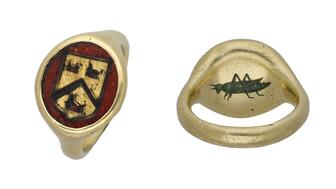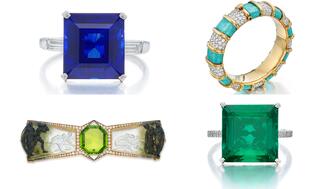Squirrel Spotting: 11 Sales Thoughts for the Season
From showing three items to asking the big question, Peter Smith gives tips for promoting a positive sales atmosphere this holiday season.

In the recap, Saunders wrote, “Americans are deeply pessimistic, with over 40 percent more people expecting the economy to be worse in the next five years than better. That’s even gloomier than in the aftermath of the global financial crisis and Great Recession in 2010.”
He also reported, “America’s economy grew at a 4.9 percent annualized rate in the third quarter, the fastest since 2021. With consumer spending accounting for two-thirds of the economy, much of the jump is down to a surprise shopping spree.”
I was struck by the contradiction in those two pieces of information and, truth be told, it resonated with me as I feel like retail jewelers exhibit those contradictions exactly.
On the one hand, we have retailers making decisions as if we were deep in the throes of the Great Recession and yet the underlying data paints an entirely different, and more positive, picture.
Independent retailers’ sales are tracking at about 2.5 percent down versus the same period last year through October. Put another way, that means we are tracking at 97.5 percent of the biggest year in the history of our business.
For context, the year before COVID (2019), we did about $62 billion in sales.
After giving back some of those gains due to the disruption of the early days of the pandemic, we finished 2020 strong, recovering almost all of the early year losses.
The year 2021 was a behemoth, with $86 billion, and, that extraordinary year was followed by an even more remarkable 2022, with $91 billion in total sales.
To be tracking only slightly behind 2022 through October is beyond my wildest expectations for 2023.
As with the seeming contradiction in Saunders’ weekly recap, wherein the facts of retail performance seem not to have made any difference in consumer behavior, I see and hear similar contradictions in the jewelry business.
There are those who seem primed to dig deep holes and jump in, while others wonder if the good times will ever end.
As we approach the most crucial few weeks of our year, we would do well to expect nothing less than the very best from ourselves and our teams through the end of the year.
Share the good news, or share no news at all, but refrain from the self-defeating predictions of doom and gloom that won’t inspire your team or your customers and may even be self-fulfilling.
Keep it simple and keep it positive.
Here are a few tips that might help.
Convert Better
Converting your foot traffic into customers is one of the best things you can do for your business.
If you convert three out of 10 walk-ins today and you up that to four out of 10 you will have increased your business by 33 percent.
If you currently convert four of 10 and you can improve that to five out of 10, you will have increased your business by 25 percent.
If you are not already doing so, chart your conversion by salesperson, and talk about it every single day.
Higher Average Ticket
With the decades-long trend of declining foot traffic, it is imperative your average ticket increases. There are brands and categories that can put pressure on your average ticket (Kendra Scott, Pandora, lab-grown diamonds, etc.).
Those and other categories can be strategically good for your business, but they also can conspire to unintentionally reduce your average ticket if you don’t manage them appropriately. Monitor your average ticket and track and discuss your performance with your sales team.
Reach Out and Touch Someone, Now
According to some sources, you are 70 percent more likely to close returning customers, and at a 30 percent higher average ticket.
Your team should be working the phones, texts, and emails now to ensure your best customers are invited in to take care of their holiday needs.
Adopt a Selling Mindset With Every Customer
Every customer is a selling opportunity and believing customers are being well-served by allowing them to walk out of your store empty-handed is a delusion.
They’re looking to fulfill a need, even when they struggle to articulate exactly what that need is, and it’s our job to positively influence them to make a purchase.
Show Three Items
When you’ve arrived at the point in your interaction where you are presenting products, deliver three options (paradox of choice) and three different price points (anchoring).
The low price point should be the customer’s budget, then an option twice the budget, and lastly an option that splits the difference between the two.
You will be amazed how often the customer selects the middle option (50 percent higher than their stated budget) and is delighted to do so.
Understand Customers’ Mindset on Price
Customers believe higher prices equal better quality. Keep that top of mind if you find yourself having a discount conversation and/or underselling the customer.
And remember, value has nothing at all to do with price, but everything to do with how that customer feels when they walk out that door after making a purchase.
Do you want them to feel like a hero, or to leave your store wondering if they might have negotiated a deeper discount?
Prioritize Selling Time
Psychologists have a term called “the law of triviality.” It means filling the hours and days with all kinds of things that have little to do with the job at hand; in a jewelry store, that is selling.
Fish while the fish are swimming and make sure that your top priority is selling time.
As you build rapport with your customer, get them to make decisions along the way. Every little decision a customer makes (this shape diamond, not that, this color gold, not that, etc.) makes the close much easier.
It will be much easier to close if the customer has participated in the decision-making process along the way.
Ask the Big Question and Use That as Your Baseline
One of the best questions you can ask a customer is, “What is most important to you about this purchase?”
Their answer should serve as your north star and baseline.
Ask that question and listen really, really closely to what they tell you.
Ask for the Sale
It has been reported that 70 percent of customers say yes when they are asked for the sale, but only 50 percent of customers are asked for the sale.
Bridging that gap is a heck of a way to grow your business.
Don’t Stop Selling After They Say Yes
When your customer says yes to the purchase, immediately begin the process again by asking, “Who else do we need to take care of today?”
If you have built a good rapport with the customer and they are ready to give you their payment information, do not assume they have only one person to buy for. Make it easy for them to handle multiple people in the same visit.
Here’s to a terrific holiday season for all!
The Latest

The heist happened in Lebec, California, in 2022 when a Brinks truck was transporting goods from one show in California to another.

The 10-carat fancy purple-pink diamond with potential links to Marie Antoinette headlined the white-glove jewelry auction this week.

The Starboard Cruises SVP discusses who is shopping for jewelry on ships, how much they’re spending, and why brands should get on board.

The Seymour & Evelyn Holtzman Bench Scholarship from Jewelers of America returns for a second year.

The historic signet ring exceeded its estimate at Noonans Mayfair’s jewelry auction this week.


To mark the milestone, the brand is introducing new non-bridal fine jewelry designs for the first time in two decades.

The gemstone is the third most valuable ruby to come out of the Montepuez mine, Gemfields said.

The countdown is on for the JCK Las Vegas Show and JA is pulling out all the stops.

Founder and longtime CEO Ben Smithee will stay with the agency, transitioning into the role of founding partner and strategic advisor.

Associate Editor Natalie Francisco shares 20 of her favorite pieces from the jewelry collections that debuted at Couture.

The top lot was a colorless Graff diamond, followed by a Burmese ruby necklace by Marcus & Co.

Gizzi, who has been in the industry since 2001, is now Jewelers of America’s senior vice president of corporate affairs.

Luca de Meo, a 30-year veteran of the auto industry, will succeed longtime CEO François-Henri Pinault.

Following visits to Vegas and New York, Botswana’s minerals minister sat down with Michelle Graff to discuss the state of the diamond market.

The “Your Love Has the Perfect Ring” campaign showcases the strength of love and need for inclusivity and representation, the jeweler said.

The former De Beers executive is the jewelry house’s new director of high jewelry for the Americas.

The New York Liberty forward is the first athlete to represent the Brooklyn-based jewelry brand.

Take a bite out of the 14-karat yellow gold “Fruits of Love Pear” earrings featuring peridots, diamond stems, and tsavorite leaves.

The one-day virtual event will feature speakers from De Beers, GIA, and Gemworld International.

The California-based creative talks jewelry photography in the modern era and tackles FAQs about working with a pro for the first time.

Al Capone’s pocket watch also found a buyer, though it went for less than half of what it did at auction four years ago.

The foundation has also expanded its “Stronger Together” initiative with Jewelers for Children.

Assimon is the auction house’s new chief commercial officer.

The De Beers Group CEO discusses the company’s new “beacon” program, the likelihood diamonds will be exempt from tariffs, and “Origin.”

The Danish jewelry giant hosted its grand opening last weekend, complete with a Pandora pink roulette wheel.

Industry veteran Anoop Mehta is the new chairman and independent director of the IGI board.

The winners of the inaugural “Kering Generation Award x Jewelry” are student Lee Min Seo and China-based startup Ianyan.



























